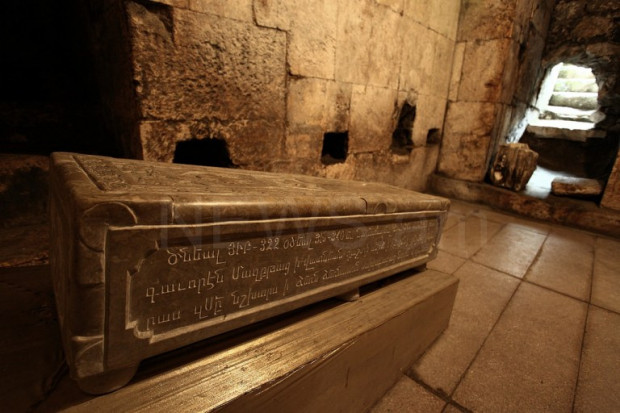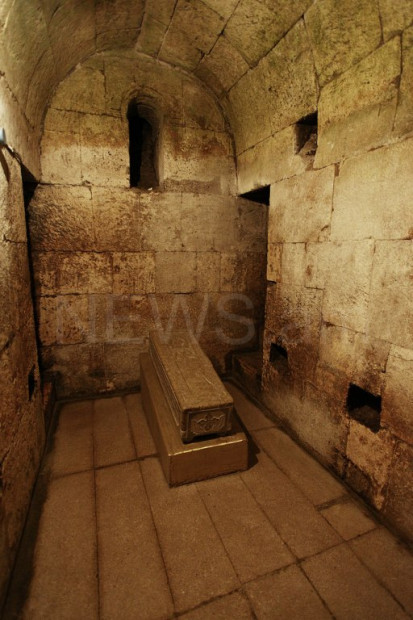The Gandzasar Monastery is located in the Mardakert District of the Artsakh Republic, and is about two hours drive from the republic’s capital city of Vararakn (Stepanakert). It stands atop of Mount Gandzasar (hence the name), a large green hill that rises above the historical town of Vank.
The name "Gandzasar" (Armenian: Գանձասար) is translated from Armenian as "Treasure Mountain." "Gandz" (Armenian: գանձ) means "treasure" and "sar" (Armenian: սար) means "mountain," which point to ancient copper and silver mines found in the vicinity. But there can be little doubt that the real treasure is the architectural and historical significance of the monastery that adorns the mountain.
Gandzasar is a walled abbey with both ecclesiastical and non-ecclesiastical buildings, the centerpiece of which is the Cathedral of St. Hovhannes Mkrtich ( St. John the Baptist; Armenian: Սբ. Հովհաննես Մկրտիչ), a large church with a cupola in the inscribed cross plan.
The foundations of the Cathedral were laid in 1216 by Prince Hasan Jalal Vahtangian, a powerful Armenian feudal lord who referred to himself as Grand Prince, Prince of Princes and King (tagavor; Armenian: թագավոր). Prince Hasan Jalal relates to one of the most ancient aristocratic families in world history—the Arranshahiks—who ruled eastern Armenian lands since early medieval times, if not well before.
Hasan Jalal’s successors, who assumed the surname Hasan-Jalalian in memory of their celebrated grandparent, branched out into two lines. The clerical line hereditarily controlled top positions of the Holy See of Gandzasar, while the original, princely one, continued administering the Province of Khachen as princes and meliks (dukes).
First records about the Gandzasar Monastery go back to the tenth century. In his encyclical titled “On the Rebellion of the House of Aghvank,” Anania Mokatsi (reigned from 946-968), Katholicos of All Armenians, writes that in order to resolve disputes which arose in 949 due to differing interpretations of the Holy Trinity, he “ordered to hold an assembly in the province of Khachen, with the participation of priests and nobility.” [1] Katholicos Anania mentions among the invited “Father Sargis, a monk from Gandzasar.” The same Father Sargis, apparently an important churchman of his time, was noted by the Armenian historian Stepanos Orbelian in his “History of the Land of Sisakan.” [2]
Gandzasar shared the turbulent history of the Armenian people. In a colophon, from 1417, the superior of the monastery deplores the situation whereby the princes of Khachen are “in the hands of lawless people” and “the House of Armenia is thus weakened.”
The monastery was sacked several times, most notably—by Mongol hordes, in the beginning of the thirteenth century. In the late eighteenth century, Gandzasar was looted by the gangs of the Turkic chieftain Ibrahim-Khalil Javanshir—a tribal lord from the family of the self-proclaimed “Khans of Karabakh.” By usurping Artsakh’s Castle of Shushi for over 50 years (until driven out and assassinated by Russians and Armenians, in 1805), Ibrahim—and his father Panah-Ali before him—had been terrorizing Gandzasar’s clergy. In 1786, this policy culminated in capturing, torturing and killing Gandzasar’s Katholikos Hovhannes Gandzasaretsi and his brothers, by Ibrahim’s henchmen. Most recently Gandzasar was attacked in 1992, in the course of Azerbaijan ’s anti-Armenian aggression and Artsakh’s heroic self-defense. But despite the challenges before them, Armenians—whether throughout the Middle Ages or in the twentieth century—always organized extraordinary measures to defend Gandzasar and shield it from damage.
Autonomous Divisions of the Armenian Apostolic Church
The Armenian Apostolic Church has been a key national institution of Armenia. It provided spiritual guidance, supported national institutions, created the Armenian alphabet, and unified the nation in times when its statehood was weakened by foreign invasions.
In medieval times, chiefly because of geographical barriers and feudal fault lines that carved up historical Armenia into separate Armenian kingdoms, key divisions of the Church (katholicosates, patriarchates and archbishoprics) often had to lead semi-autonomous existence. Nonetheless, all of them recognized the authority of one central katholicosate (top patriarchate) of the Armenian Apostolic Church: the Mother See (Armenian: Մայր Աթոռ).
The head of the Mother See is the supreme patriarch of the Church, called the Katholicos of All Armenians (Armenian: Կաթողիկոս Ամենայն Հայոց). His traditional and present residence is in Saint Echmiadzin, the birthplace of Armenian Christianity, which is oftentimes referred to as “Armenian Vatican.” A large religious complex with churches and seminaries, Saint Echmiadzin occupies a central quarter of the city of Vagharshapat, and is located 15 miles east of Yerevan, the capital of the modern Republic of Armenia.
From the 14th century to 1836, the Gandzasar Monastery hosted the Katholicosate of Aghvank (Armenian: Աղվանից Կաթողիկոսություն), the easternmost subdivision of the Armenian Apostolic Church. When the Katholicosate of Aghvank moved to Gandzasar from the Amaras Monastery, it became known as the Holy See of Gandzasar. As such, Gandzasar was in charge of parishes in two historical Armenian provinces, Artsakh and Utik, and all territories that lied between the eastern borderlands of Armenia and the Caspian Sea.
The importance of the Holy See of Gandzasar in Armenian political and religious life was very high. Gandzasar’s power peaked two
times. Near the end of the fourteenth century, when the Armenian Kingdom of Cilicia, an independent Armenian state on the Mediterranean Sea, was conquered by the Mamluk Sultanate of Egypt , the idea was born—though not realized—of transferring to Gandzasar the Mother See, then in Cilicia. [3] Next time, in the beginning of the eighteenth century, Gandzasar’s power expanded under its strong leader, Katholikos Yesai Hasan-Jalalian. Despite the muted displeasure of the Mother See of Saint Echmiadzin, for several decades Gandzasar was recognized by the Russian imperial court and European monarchs as the sole representative of all Armenian Christians. [4]
Gandzasar was not the only semi-autonomous subdivision of the Armenian Apostolic Church. Below is an incomplete list of some other units of the Church, which had analogously self-governing status in various periods of the Church’s history:
* Holy See of Cilicia. Also known as the Katholicosate of the Great House of Cilicia, the Holy See of Cilicia was based in various parts of this Mediterranean region. Its most notable headquarter was the in city of Sis, capital of the independent Armenian Kingdom of Cilicia (1078-1375). For several centuries, the kingdom housed the Mother See, which moved its headquarters from Saint Echmiadzin in 1292, seeking the security and protection of Cilicia’s Armenian rulers. When the Mother See moved back to Saint Echmiadzin, in 1441, Cilicia organized its own ecclesiastical domain. The Holy See of Cilicia exists to this day, as an integral part of the Armenian Apostolic Church. In 1930, after the establishment of the Turkish Republic, it moved its headquarters from Sis to Antelias, Lebanon.
* Holy See of Akhtamar. The island of Akhtamar on the Lake Van, with its large and unique cathedral of St. Cross, served as a spiritual home of Armenia ’s southern Kingdom of Vaspurakan and adjacent territories, from 1113 to 1895. Khachatur III, who died in 1895, was the last Katholikos of Akhtamar. The last vestiges of the Akhtamar Katholicosate were destroyed by Ottoman Turks during the Armenian Genocide (1915-1922).
* Metropolitanate of Syunik. Also known as the Holy See of Syunik, this division of the Armenian Apostolic Church was in charge of parishes in Armenia ’s eastern province of Syunik, beginning from the 10th century. The Metropolitanate was fully instituted in 1286, and its status confirmed by the Mongol Khan. It was housed in the Tatev Monastery, located 100 miles south-west of Gandzasar, on the territory of modern Province (marz) of Syunik of the Republic of Armenia.
* Patriarchate of Constantinople. In 1461, Sultan Muhammad II laid the ground for the establishment of the Armenian Patriarchate of Constantinople by elevating the status of Bishop Hovakim of Bursa. Largely because the Mother See of Saint Echmiadzin was based on the territory of Eastern Armenia—then part of rival Persia—the Sultan sought to control Armenians living within the boundaries of his growing empire through a different patriarchal authority. The katholicosates of Akhtamar and Cilicia were later subordinated to the Patriarchate of Constantinople in most administrative matters. The Patriarchate of Constantinople exists to this day, as an integral part of the Armenian Apostolic Church.
* Patriarchate of Jerusalem. In 1307, King Oshin I, of the Armenian Kingdom of Cilicia, and the Cilicia-based Katholicos Constantine III, forced the Armenian Church to adopt the dogmatic and ritual changes of the Council of Sis, which were inspired by Catholicism. Bishop Sargis of Jerusalem, wishing to preserve the purity of the doctrine of the Armenian Apostolic Church, obtained an official document from the Sultan of Egypt, permitting him to take his See from the control of the Katholicos of All Armenians to function independently as of 1311. Patriarchate of Jerusalem exists to this day, as an integral part of the Armenian Apostolic Church. It is domiciled in the Armenian Quarter of Jerusalem’s Old Town.
Edited by Zartonk, 09 December 2009 - 04:41 PM.




















